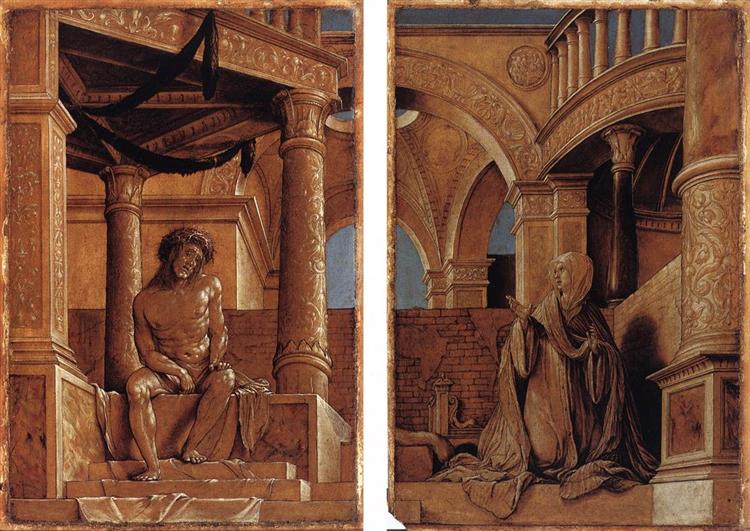Beschreibung
Das Gemälde "Diptico mit Christus und Mater Painful", das 1520 von Hans Holbein, dem Jüngeren, geschaffen wurde, ist ein Meisterwerk, das sich in der Tradition der Renaissance -Kunst einschreibt, die durch seine bemerkenswerte Liebe zum Detail, seine emotionale Tiefe und seine ausgewogene Komposition gekennzeichnet ist. Holbein, a kunstmeister In der Darstellung menschlicher Figuren gelingt es es, in diesen Diptychon -tiefen und komplexen Emotionen zu erfassen, die mit dem Betrachter in Resonanz stehen, und sowohl Hingabe als auch Klage hervorruft.
Im linken Feld wird die Figur Christi präsentiert, die von selbst ein faszinierendes visuelles Ereignis ist. Die Darstellung Christi ist feierlich, sein Gesicht spiegelt nicht nur Leiden, sondern auch eine fast göttliche Gelassenheit wider. Die Körperhaltung des Körpers zeigt eine gut definierte Muskulatur, die Holbeins Dominanz über die menschliche Anatomie zeigt. Die Verwendung von schwachen und nuancierten Farben im Mantel Christi steht im Gegensatz zu ihrer blassen Haut und betont seine Zerbrechlichkeit und Verletzlichkeit. Die Dornenkrone, die seinen Kopf und Wunden in ihren Händen schmückt, sind offensichtliche Erinnerungen an ihr Opfer, während ein dunkler Hintergrund die Figur umrahmt und das Gefühl der Isolation und des Dramas der Szene erhöht.
Rechts tritt die schmerzhafte Materie, die Personifizierung von Traurigkeit und mütterliche Schmerzen, in einer Atmosphäre voller emotionaler Schwere auf. Sein Ausdruck ist von Angst, mit Augen, die über die Oberfläche hinaus zu schauen, mit einem tiefen Verlustgefühl. Die Verwendung von Farbe in diesem Panel ist meisterhaft; Die reichen blauen und roten Töne ihrer Kleidung bezeichnen sowohl Adel als auch Leiden. Der zarte Rand seines Mantels steht im Gegensatz zur Rohheit des Hintergrunds, die zwar auch dunkel ist, eine Nuance, die seine Klage innerhalb einer visuellen Erzählkonstruktion kontextualisiert. Die Heilige Familie ist ein gemeinsames Thema in der Kunst dieser Zeit, und Holbein ruft diese Tradition hervor, indem er ihre Darstellung einer tastbaren Menschheit durchdringt, die es dem Betrachter ermöglicht, sich emotional mit den Charakteren zu verbinden.
Interessanterweise spiegelt die Arbeit den unverwechselbaren Stil von Holbein wider, der durch eine akribische Detailarbeit es schafft, seine Figuren ein Gefühl von Realismus und Leben zu verleihen. Dieser Stil beschränkt sich nicht nur auf menschliche Figuren, sondern erstreckt sich auch auf die Darstellung von Textilien und anderen Elementen. Liebe zum Detail in den Texturen von Kleidung und in Mimik begleitet eine visuelle Erzählung, die sowohl persönlich als auch universell ist und eine Reflexion über das menschliche Leiden ermöglicht.
Der Diptychon ist repräsentativ für die Verwendung des rechteckigen, charakteristisch für die religiöse Kunst der Zeit und erleichtert eine klare Abgrenzung zwischen den Szenen. So wirkt der Diptychon nicht nur als künstlerisches Objekt, sondern auch als Mittel zur Meditation über die Leidenschaft Christi und den Schmerz seiner Mutter, mit dem sich die Öffentlichkeit der Zeit leicht identifizieren könnte.
Hans Holbein, der junge Mann, wird oft für seine Fähigkeit in Erinnerung bleiben, das Heilige und den Menschen zu vereinen, und "diptisch mit Christus und der Mater Painful" wird als außergewöhnliches Beispiel für diese Fähigkeit dargestellt. In einem historischen Kontext, in dem Religion und künstlerische Repräsentation intrinsisch miteinander verbunden waren, wird dieses Werk als Zeugnis der Kunstfähigkeit errichtet, um die Tiefen der menschlichen Erfahrung zu erforschen. Die emotionale Nähe, die Holbein in diesem Diptychon erreicht, ermöglicht es dem Betrachter nicht nur zu beobachten, sondern auch zu spüren, was die Charaktere zu experimentieren scheinen und die Farbe in ein starkes Fahrzeug der Empathie und Reflexion verwandeln. Zusammenfassend lässt sich sagen, dass diese Arbeit nicht nur die technische Beherrschung seines Autors, sondern auch die Universalität des menschlichen Leidens in der Erfahrung der Renaissance -Kunst hervorhebt.
KUADROS ©, eine berühmte Farbe an Ihrer Wand.
Handgefertigte Ölgemälde, mit der Qualität professioneller Künstler und dem unverwechselbaren Siegel von KUADROS ©.
Pictures Reproduction Service mit Zufriedenheitsgarantie. Wenn Sie mit der Nachbildung Ihres Gemäldes nicht vollständig zufrieden sind, erstatten wir Ihr Geld zu 100%.

